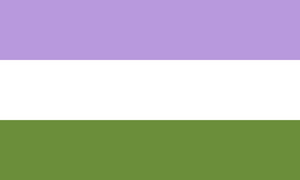Genderqueer flag: Difference between revisions
imported>TXJ No edit summary |
imported>TXJ |
||
| Line 22: | Line 22: | ||
*[http://genderqueerid.com/about-flag Genderqueer Identities: About the flag] | *[http://genderqueerid.com/about-flag Genderqueer Identities: About the flag] | ||
*[http://genderqueerid.com/post/12724222343/im-curious-if-youd-consider-this-flag-more-of-an Genderqueer Identities: Is this flag more of a non-binary flag?] | *[http://genderqueerid.com/post/12724222343/im-curious-if-youd-consider-this-flag-more-of-an Genderqueer Identities: Is this flag more of a non-binary flag?] | ||
*[https://majesticmess.com/2019/07/14/interview-creator-of-the-genderqueer-flag/ Interview: Creator of the Genderqueer Flag] | |||
==References== | ==References== | ||
Revision as of 23:37, 9 June 2020
The Genderqueer flag was designed by Marilyn Roxie with input from the readers of Genderqueer Identities. The flag is Creative Commons Attribution licensed.
By coincidence, the colors are similar to the British Suffragette Flag which is sometimes used by TERFs online, causing some confusion.[1] The creator of the genderqueer flag had no knowledge of the British Suffragette Flag.[2]
Description
The following description was taken from Marilyn Roxie's About the flag page:
The genderqueer pride flag is a Marilyn Roxie design, 3rd and final version created in June 2011, modified from version 1.0 in June 2010, and 2.0 in September 2010. The design is aesthetically similar to the gay and lesbian, bisexual, transgender, asexual, and pansexual flags; that is, horizontal bars of color with special meaning. The meaning of the colors in the genderqueer flag design are as follows:
Lavender (#b57edc): The mixture of blue and pink (traditional colors associated with men and women, present on the transgender pride flag) as lavender is meant to represent androgynes and androgyny. Also represents the “queer” in genderqueer, as lavender is a color that has long been associated with “queerness” , including gay, lesbian, and bisexual communities.
White (#ffffff): Meant to represent agender identity, congruent with the gender neutral white on the transgender pride flag.
Dark Chartreuse Green (#498022): The inverse of the lavender color; meant to represent “third gender” identity, i.e. those whose identities are defined outside of and without reference to the binary.
The three colors are not meant to indicate that any of these identities are entirely separate or opposites of one another conceptually; they are all interrelated as well as key concepts in their own right, and there are more concepts and variation of gender and sexuality present that tie into genderqueer identities than can be listed here. The purpose of the flag is to help create visibility for the genderqueer community and related identities.
(Lack of) use by nonbinary.wiki
Because queer is a reclaimed slur and some members of the nonbinary community do not feel comfortable identifying with it, nonbinary.wiki has opted to use the nonbinary flag for a logo.
External links
- Genderqueer Identities: About the flag
- Genderqueer Identities: Is this flag more of a non-binary flag?
- Interview: Creator of the Genderqueer Flag
References
- ↑ u/queerfox13 (2 October 2018). "r/asktransgender - Does anyone know why so many Twitter TERFs have the genderqueer flag as their icon?". reddit. Retrieved 31 May 2020.
u/queerfox13
- ↑ Roxie, Marilyn (24 April 2013). "On the Genderqueer and Non-Binary Flag and Suffragette Colours in the UK". GENDERQUEER AND NON-BINARY IDENTITIES. Retrieved 31 May 2020.

